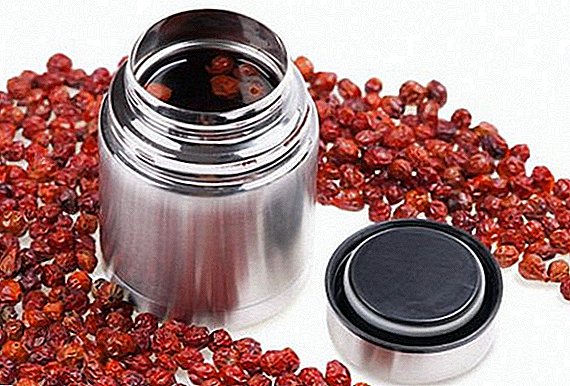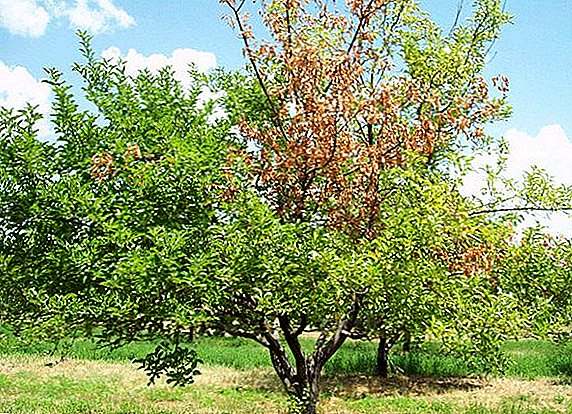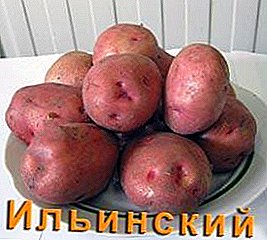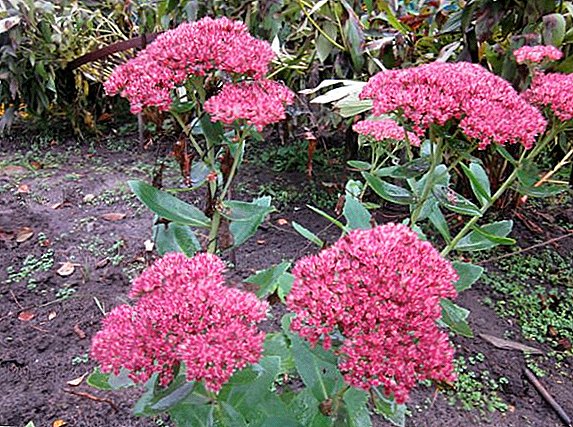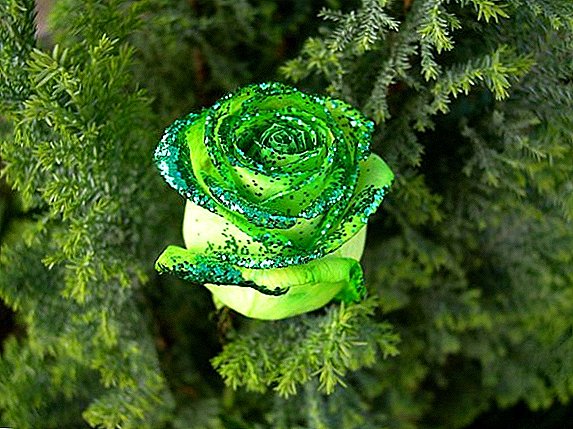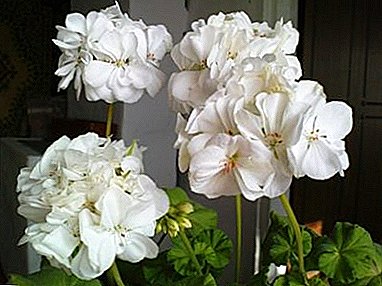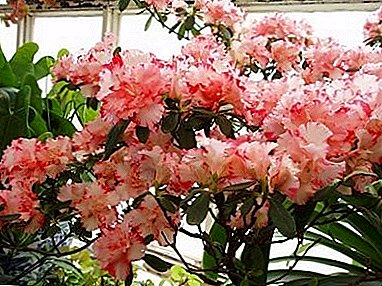
In the middle of the nineteenth century, a naval officer, Aleksandr Egorovich Shlippenbach, sailed along the shores of the Korean Peninsula on the ship "Pallas" and saw a beautiful bush completely covered with large pink flowers. Today it is called Rhododendron Schlippbach or royal azalea.
Characteristic and description
The most beautiful of all deciduous rhododendrons withstand cold, not afraid of even 30-degree frost. In nature, on stony mountain slopes and in light forests of the Far East, it grows up to 4 m, and rarely exceeds 1.5 m in culture.
A photo





Root system
She has azaleas superficialtherefore, it is impossible to choose “competitors” for nutrients on the plot in neighbors, whose roots also lie shallow.
Best neighbors for her - plants with taproot. For example, pine, spruce, and from fruit - pear, spreading apple tree, cherry.
Trunk and leaves
Mature shoots of this species are covered with light gray bark, and the young ones are brownish in color.
Large long (up to 10 cm) leaves stick with bright green whorls at the ends of the shoots. In the fall, they become yellow-red, and in October the azalea flies.
Flowers
There may be a thousand of them in one bush! They bloom in April-May a little earlier than the leaves or together with them and cover the plant with a cap of pink (occasionally white) foam. The flowers are large, pink corolla in purple speckles - hold for 10-14 days and smell very nice.
How to care?
Landing
The best time for planting - the beginning of spring, but you can plant in early autumn. In order for rhododendron to grow well, it should be protected from the wind by a wall or fence - the northern side will do. Azalea loves a scattered shadow - in a sunny place you can not wait for flowers.
Priming
This plant is needed well drained acidic soil (pH 3.0-5.0). The pit for planting (depth 50, width 60 cm) is filled with a mixture of high-moor peat (3 parts) and rotted compost earth (1 part), and a 2-3-year-old manure can be taken instead. If the soil is clay, add sand. When planting roots straighten hands and sprinkle with soil no higher than the root collar. Top - a layer of crushed pine bark or sawdust from coniferous trees.
Watering and humidity
Rhododendron loves moisture. Full drying of the soil for him is destructive. On hot days and with a long absence of rain, he needs regular abundant watering. The best option is rainwater.. Flowing is also suitable, but first check its hardness (for example, using soap - if it is well washed, it means the water is soft). Hard water can be softened by dripping citric acid into it at the rate of 3-4 ml per 10 liters.
Water from the tap is not suitable for irrigation - it has chlorine and lime, which azalea does not tolerate.
On hot days, the azalea needs to be humidified. It should be often sprayed with soft water.
Fertilizer
It is necessary to feed up Shlippenbach three times a season: before flowering, right after, and on the eve of autumn.
- For the first two feedings suitable either special fertilizer for rhododendrons (it should be taken at 20-30 g per bush), or Kemira wagon (2-3 g per 1 liter of water). To this, it is good to add 5-10 grams of any nitrogenous fertilizer, for example, urea.
 Autumn top dressing is different. Nitrogen is no longer required, and you need 30 g of superphosphate + 15 g of potassium sulfate per bush. You can add and a little complex fertilizer. This will prevent the growth of shoots, which are unnecessary in the fall, and will strengthen the wood.
Autumn top dressing is different. Nitrogen is no longer required, and you need 30 g of superphosphate + 15 g of potassium sulfate per bush. You can add and a little complex fertilizer. This will prevent the growth of shoots, which are unnecessary in the fall, and will strengthen the wood.- Twice a year - in the spring (as the snow melts) and at the end of the summer you need to sprinkle the soil under the rhododendron thick layer (up to 10 cm) of conifer sawdust. Such mulching will not allow the earth to dry out, and weeds to grow. At the same time and the desired acidity of the soil will support.
Temperature conditions
The most comfortable is this: in the summer + 18-24ºС, in the winter up to - 20ºС, although the Schlippenbach rhododendron is winter-hardy, it can withstand even more severe cold. Drafts him uneasy.
Bloom
To prepare the bush for flowering - feed it in the spring, as mentioned above.
During flowering, to prolong it, grab the wilted flowers. The cooler outside, the longer the bush will bloom. If the weather is hot - water and spray it.
When spraying, do not touch the flowers and buds, otherwise they quickly fade or begin to rot.
After flowering, it is fed a second time, because During this period, flower buds are laid for the next season.
Do I need to trim?
After flowering, too long branches and weak buds are removed, forming a beautiful crown. Over the summer and autumn, the bush will throw out new shoots.
Before winter, they need to be cut, and then next year the rhododendron will bloom even more magnificently.
Transfer
If the rhododendron needs to be transplanted, it can be done by transfer at any time, except for the flowering period and late autumn.
Azalea roots are compact - it's easy to dig. Try not to disturb the earth bed, because roots are very sensitive.
Breeding methods
Growing from seed
- It is better to buy seeds in a nursery or agrocomplex.
- You can store them up to 4 years in a sealed container in a cool place, then they do not lose germination.
- Sow the seeds in winter (December-February).
- Soil can be found in the store and add to it for 1 part the same half-broken pine needles. If there are no needles, you can replace it with high-moor peat (it is also on sale). This soil is friable; it perfectly passes air and moisture, its acidity is pH 3.5 - 4.5.
- Put drainage on the bottom of the dish, then the ground - it should be slightly moistened.. Sow the seeds and lightly tuck them into the soil, cover them with foil and place them where it is warm, light and humid. In winter, the seeds need light - light day for them should last at least 16 hours.
- Temperature for germination + 18-24ºС.
- The first shoots can go after a week, but sometimes they are waiting a month or longer. When the seeds have risen, the film is removed and put the dishes in a cooler place (for example, closer to the window glass).
- Watering needs abundant, but infrequent.
- As the first true leaves go - transplant the seedlings into separate pots.
Reproduction by cuttings
After the azalea has faded, shoots are cut off from the bush for about six months.
Put them in a shallow dish, in the usual soil for rhododendrons, cover with foil or bag and regularly watered.
After 1.5 months, the cuttings will take root, and then they can be seated separately.
Wintering
Autumn preparation
If autumn is dry, azaleas need good watering. - each bush 10-12 liters of water, it will need a plant in the winter. Do not forget also about top dressing and pruning, as mentioned earlier.
Preparing for the winter
In principle, this species is able to winter without shelter, but severe frosts can affect future flowering, because delicate flower buds are damaged, and annual shoots at the ends frost out. Therefore, it is better to cover the Rhododendron Slippenbach for the winter.
 With the onset of the first frosts (in the middle lane, they can happen at the end of August), cover the bush with sacking and tie it on top so as not to blow the wind.
With the onset of the first frosts (in the middle lane, they can happen at the end of August), cover the bush with sacking and tie it on top so as not to blow the wind.
If the bush is sprawling, first strapping it, lightly gather the branches into a pile and build a carcass or a hut over it, and then throw bags or light lutrasil on top.
Between the branches of a wintering bush, you can stick a fir or pine spruce branches - in the spring it will protect the "sleepy" bush from sunburn.
When it snows in April, choose a cloudy day and remove the shelter, and leave the lap branches inside for another three days. The bright sun can burn the young shoots, and they turn brown - rhododendron takes time to get used to the bright light.
Diseases and pests
Rhododendron growing in open ground often comes from pests.
Snails and slugs love to eat the soft juicy leaves of the plant.
What to do: inspect the bush, manually collect all gastropods "comrades", and in order to continue to repel their appetite, process the bush with an 8-percent solution of the fungicide. Thiram and TMDM are suitable.
 Spider mite, weevils, rhododendron bugs. Ticks infest heat with low humidity, it is easier to prevent their occurrence by regular spraying than to treat the plant.
Spider mite, weevils, rhododendron bugs. Ticks infest heat with low humidity, it is easier to prevent their occurrence by regular spraying than to treat the plant.
What to do: You can get rid of all three types of pests by treating azalea with the diazinon insecticide. If rhododendron was overpowered by weevils, then it will be necessary to water this chemical not only on the bush, but also on the soil under it.
Mealybugs, scale insects, rhododendral flies.
What to do: exterminate Karbofos.
Fungal diseases: rust, spotting - develop due to poor aeration of the roots.
What to do: loosen the soil, treat rhododendron with preparations containing copper sulphate (for example, Bordeaux mixture).

Chlorosis - the most frequent problem: the Schlippenbach foliage turns yellow. Cause: lack of iron and manganese.
What to do: check the acidity of the soil, if it is low - lead to the norm. Feed the plant complex fertilizer.
Shlippenbach rhododendron can suffer due to the stagnation of moisture, chaotic fertilizing, impaired soil acidity, winter drying, burns received in spring in the sun. All this can be avoided if you take care of the plant correctly, carry out pruning in time, burn diseased foliage, spray the bush with fungicides, exterminating pests.
If you create conditions for royal azaleas that are close to natural ones, she will certainly respond to care and attention and give you incomparable beauty that has once opened to the Russian seaman Shlippenbach.
Useful information
You can read other materials on the topic and learn more:
- Azalea - winter decoration of the window sill
- Azalea: rules and conditions of the plant
- Evergreen Rhododendron Yakushiman
- Gentle clouds land in June: rhododendrons (azaleas) in garden culture


 Autumn top dressing is different. Nitrogen is no longer required, and you need 30 g of superphosphate + 15 g of potassium sulfate per bush. You can add and a little complex fertilizer. This will prevent the growth of shoots, which are unnecessary in the fall, and will strengthen the wood.
Autumn top dressing is different. Nitrogen is no longer required, and you need 30 g of superphosphate + 15 g of potassium sulfate per bush. You can add and a little complex fertilizer. This will prevent the growth of shoots, which are unnecessary in the fall, and will strengthen the wood.

